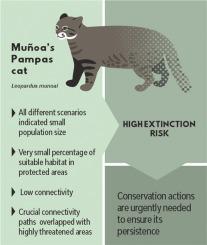Journal for Nature Conservation ( IF 2.2 ) Pub Date : 2021-05-07 , DOI: 10.1016/j.jnc.2021.126009 Flávia P. Tirelli , Tatiane C. Trigo , Diego Queirolo , Carlos Benhur Kasper , Nadia Bou , Felipe Peters , Fábio D. Mazim , Juan Andrés Martínez-Lanfranco , Enrique M. González , Caroline Espinosa , Marina Favarini , Lucas Gonçalves da Silva , David W. Macdonald , Mauro Lucherini , Eduardo Eizirik

|
Muñoa’s pampas cat (recently proposed to be a distinct species, Leopardus munoai) is a small felid that is endemic to the Uruguayan Savanna ecoregion (encompassing southern Brazil, north-eastern Argentina and Uruguay). Previous studies have suggested that it is threatened, but its conservation assessment has been hampered by the scarcity of data on its ecology, including spatial distribution, population size, and connectivity. To address these issues, we developed current spatial distribution models and used them to: (i) identify the environmental variables affecting L. munoai habitat suitability; (ii) generate estimates of population size to assess its conservation status based on IUCN criteria; (iii) estimate habitat suitability in protected areas; (iv) identify potential paths of connectivity among protected areas and sites of confirmed occurrence; and (v) assess the proportion of the estimated connectivity paths that overlap with threatened areas (based on future threat projections). Our results indicated higher habitat suitability in the central area of the species’ distribution. All estimates (based on different demographic assumptions) indicated that L. munoai should be categorized in one of the IUCN threatened categories. Worryingly, several estimates indicated that it may be Critically Endangered. Only 0.73 % of its high-suitability landscape is presently protected, and connectivity among most protected areas and occurrence records was low. Additionally, areas with estimated connectivity among occurrence records mostly overlapped with regions with a high level of future habitat loss threat (92.46 %), highlighting the urgent need for an international approach to ensure the long-term survival of this elusive felid.
中文翻译:

乌拉圭萨凡纳生态区的特有猫科动物Muñoa的南美大草原猫的高灭绝风险和有限的栖息地连通性
穆尼阿(Muñoa)的南美大草原猫(最近被提议是一种独特的物种,Leopardus munoai)是乌拉圭萨凡纳生态区(包括巴西南部,阿根廷东北部和乌拉圭)特有的小猫科动物。先前的研究表明,它受到威胁,但是其保护评估因其生态学数据(包括空间分布,人口规模和连通性)的稀缺而受到阻碍。为了解决这些问题,我们开发了当前的空间分布模型,并将其用于:(i)确定影响穆氏乳杆菌的环境变量栖息地的适宜性;(ii)产生人口规模的估计数,以根据自然保护联盟的标准评估其保护状况;(iii)估计保护区的生境适宜性;(iv)查明保护区和已确认发生地点之间连通的潜在途径;(v)评估与受威胁地区重叠的估计连通路径的比例(基于未来的威胁预测)。我们的结果表明该物种分布中心区域的栖息地适应性更高。所有估计(基于不同的人口假设)均表明穆氏乳杆菌应归入IUCN威胁类别之一。令人担忧的是,一些估计表明它可能会受到严重威胁。目前,其高适应性景观中只有0.73%得到了保护,而且大多数保护区和发生记录之间的连通性很低。此外,在发生记录之间具有估计连通性的区域大多与未来栖息地丧失威胁程度高的区域(占92.46%)重叠,这突显了迫切需要采取国际方法来确保这种可捉摸的猫科动物的长期生存。





















































 京公网安备 11010802027423号
京公网安备 11010802027423号